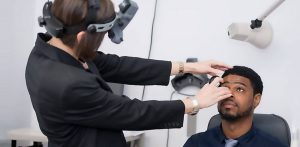What is sixth nerve palsy?
Sixth nerve palsy, also called abducens nerve palsy, is a rare condition that occurs when the sixth cranial nerve, also called the abducens nerve, becomes damaged.
Each year, around 11 in 100,000 people are diagnosed with sixth nerve palsy.
The sixth cranial nerve is responsible for sending signals to the lateral rectus muscle. This small external eye muscle attaches to the outer side of your eye and turns your eye outward, away from your nose.
When the sixth cranial nerve becomes damaged, it prevents the lateral rectus muscle from contracting and results in an inward eye turn (esotropia) and double vision.
What causes sixth nerve palsy?
Sixth nerve palsy is generally diagnosed in adults above the age of 70, when diabetes (23%) and hypertension (20%) are most prevalent. Sixth nerve palsy can also be present at birth, or result from trauma or medical condition. However, in up to 30 percent of cases, the underlying cause of sixth nerve palsy is unknown.
The most common causes of sixth nerve palsy include:
- Diabetes
- Hypertension
- Skull fracture or TBI
- Stroke
- Lyme disease or other infection
- Brain tumor
- Nerve inflammation
- Multiple sclerosis
- Meningitis
If you notice any changes to your vision, schedule an appointment with an eye doctor as soon as possible.
SEE RELATED: Neuro-Optometric Rehabilitation FAQs
What are the symptoms of sixth nerve palsy?
Depending on the underlying cause of the condition, sixth nerve palsy can affect either one or both eyes.
Double vision is the most common symptom of sixth nerve palsy, especially when both eyes are open, when looking at distant objects or when looking in the direction of the affected eye.
Strabismus, or an eye turn, is another common symptom of sixth nerve palsy that causes the affected eye to turn toward the nose.
Types of sixth nerve palsy
There are two different types of sixth nerve palsy:
1. Isolated sixth nerve palsy occurs without any additional symptoms, usually as a result of any of the following conditions:
- Injury
- Viral illness
- Hypertension
- Diabetes
2. Non-isolated sixth nerve palsy occurs when additional symptoms appear as well, including any of the following:
- Eyelid droop (ptosis)
- Fever
- Headache
- Nausea and vomiting
- Hearing loss
- Facial weakness
- Decreased facial sensation
How is sixth nerve palsy diagnosed?
To obtain a diagnosis of sixth nerve palsy, your doctor will conduct a thorough medical history, and a physical and neurological exam. If your doctor suspects sixth nerve palsy, you will be referred to an eye doctor for further testing.
Brain imaging and blood tests may be required as well, to rule out a range of possible conditions that may be causing your symptoms.
How is sixth nerve palsy treated?
Treatment of sixth nerve palsy will depend on its underlying cause, but may include:
- Vision therapy
- Antibiotics to treat a bacterial infection
- Corticosteroids to reduce inflammation
- Surgery or chemotherapy to eliminate a tumor
Vision therapy is an effective treatment option for some patients with acquired sixth nerve palsy, as it can help to improve eye movements and reduce or even eliminate double vision.
In some cases, there may not be a specific treatment for the underlying cause. However, if the condition is due to a virus or following a trauma, symptoms from sixth nerve palsy may improve on their own within a few months.
To promote healing and improve vision, your eye doctor may recommend any of the following treatments:
- Eye patching to correct double vision
- Prism lenses to help improve binocular vision
- Botox injections to temporarily paralyze the unaffected eye muscle and improve eye alignment
- Eye muscle surgery to realign the eyes
Surgery is usually only recommended as a last resort if all other treatments prove to be unsuccessful.
LEARN MORE: Guide to Vision Therapy
If you notice any changes to your vision, especially double vision or an eye turn, schedule an appointment for an eye exam.
The sooner you receive a proper diagnosis, the greater your chances of achieving optimal treatment results.










